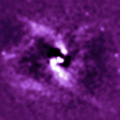Hot Galactic Arms Point To Vicious Cycle
Chandra's image of the elliptical NGC 4636 shows spectacular symmetric arms, or arcs, of hot gas extending 25,000 light years into a huge cloud of multimillion-degree-Celsius gas that envelopes the galaxy. At a temperature of 10 million degrees, the arms are 30 percent hotter than the surrounding gas cloud.
The temperature jump, together with the symmetry and scale of the arms indicate that the arms are the leading edge of a galaxy-sized shock wave that is racing outward from the center of the galaxy at 700 kilometers per second. An explosion with an energy equivalent to several hundred thousand supernovas would be required to produce this effect.
This eruption could be the latest episode in a feedback cycle of violence that keeps the galaxy in a state of turmoil. The cycle starts when a hot gas cloud that envelops the stars in the galaxy cools and falls inward toward a central, massive black hole. The feeding of the black hole by the infalling gas leads to an explosion that heats the hot gaseous envelope, which then cools over a period of several million years to begin the cycle anew.
|
||||||||||||||||||||||||||
This Chandra X-ray Observatory image of the elliptical galaxy NGC 4636 has a bright white-blue center and is surrounded by darker blue specks and blobs. The image shows spectacular symmetric arms, or arcs, of hot gas extending 25,000 light years into a huge cloud of multimillion-degree-Celsius gas that envelopes the galaxy. The arcs look like two interlocking "U" shapes, almost like an hourglass on its side. At a temperature of 10 million degrees, the arms of this galaxy are 30 percent hotter than the surrounding gas cloud.






